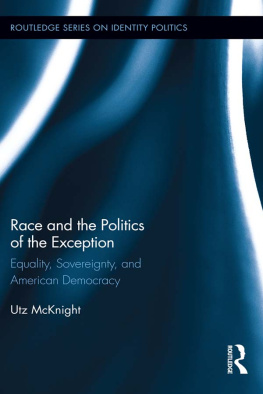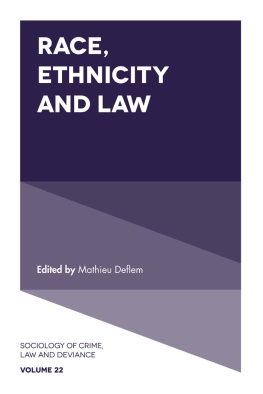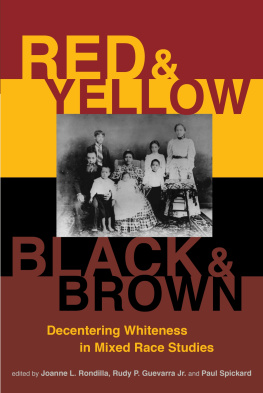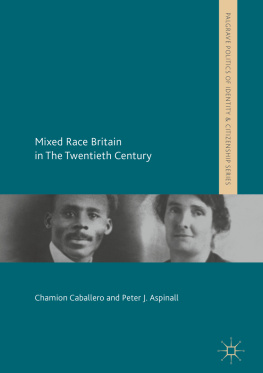White Enough to Be American?
2008 The University of North Carolina Press
All rights reserved
Designed by Kimberly Bryant
Set in Scala and Scala Sans by Keystone Typesetting, Inc.
Manufactured in the United States of America
The paper in this book meets the guidelines for permanence and durability of the Committee on Production Guidelines for Book Longevity of the Council on Library Resources.
Library of Congress Cataloging-in-Publication Data
Basson, Lauren L.
White enough to be American? : race mixing, indigenous people, and the boundaries of state and nation / by Lauren L. Basson.
p. cm.
Includes bibliographical references and index.
ISBN-13: 978-0-8078-3143-4 (cloth : alk. paper)
ISBN-13: 978-0-8078-5837-0 (pbk. : alk. paper)
1. Indians of North AmericaMixed descentLegal status, laws, etc.History. 2. Racially mixed peopleLegal status, laws, etc.United StatesHistory. 3. Racially mixed peopleLegal status, laws, etc.HawaiiHistory. 4. Indigenous peoples United StatesGovernment relationsHistory. 5. Indigenous peoplesLand tenure United StatesHistory. 6. MiscegenationPolitical aspectsUnited StatesHistory. 7. United StatesRace relationsPolitical aspectsHistory. 8. European Americans AttitudesHistory. 9. CitizenshipUnited StatesHistory. 10. NationalismUnited StatesHistory. I. Title.
E99.M693B37 2008
323.1197dc22 2007027979
Portions of this book were previously published in a different form: Fit for Annexation but Unfit to Vote? Debating Hawaiian Suffrage Qualifications at the Turn of the Twentieth Century, Social Science History 29, no. 4 (2005): 57595; used by permission. Savage Half-Breed, French Canadian or White US Citizen? Louis Riel and US Perceptions of Nation and Civilisation, National Identities 7 (2005): 369 88; the journal's website is ; used by permission of Taylor & Francis (UK) Journals. Foreign Bodies, Alternative Politics and the Boundaries of Americanism, Hagar 6, no. 2 (2006): 2133; used by permission. Challenging Boundaries and Belongings: Mixed Blood Allotment Disputes at the Turn of the Twentieth Century, in Boundaries and Belonging: States and Societies in the Struggle to Shape Identities and Local Practices, ed. Joel Migdal (Cambridge: Cambridge University Press, 2004), 15176.
12 11 10 09 08 5 4 3 2 1
To
JOEL S. MIGDAL
A true mentor and a real mensch
Contents
1 Mixed Blood Americans:
The Jane Waldron and Barney Traversee Allotment Disputes
2 Mtis Americans:
Louis Riel and the Northwest Territories
3 Annexed Americans:
Robert Wilcox, Home Rule, and Self-Government for Hawaii
4 Anarchist Americans:
Lucy Parsons, Foreign Bodies, and American Soil
Illustrations
Jane Waldron
Eudora Traversee
Louis Riel
Louis Riel addressing the jury during his trial for treason
Robert Wilcox in Italian uniform
Robert Wilcox as delegate to Congress
Lucy Parsons
Note on Terminology
Many of the words and phrases that I use in this book are terms that come directly from the late nineteenth- and early twentieth-century cases that I examine. These include phrases such as racially mixed, political competence, fitness for self-government, and a host of others. I also use many contemporary terms, including America and American, whose conventional usage I do not necessarily endorse. My purpose in introducing these terms in this book is to provide a critical assessment of their contested meanings and of their contributions to definitions of the U.S. nation and state. In an attempt to indicate that my intention was to interrogate rather than to adopt this terminology uncritically, I initially placed many of these terms in quotation marks throughout the text. Out of concern that the overuse of quotation marks might be distracting to the reader, however, I left some terms unmarked, although my stance toward these terms was still a critical one.
As I reviewed the text, I felt concerned that my choice of which terms to place in quotation marks and which to leave unmarked seemed haphazard. Matthew Frye Jacobson has commented on the unexamined racial certainty that such selective practices denote and has observed, A principled consistency on this score is rendered very difficult by the culture within which we operate (Jacobson 1998, Note on Usage). Following Jacobson's precedent in part, I ultimately decided to leave most terms, including archaic phrases, unmarked unless they have explicitly derogatory connotations in historical or contemporary contexts (e.g., mixed blood and half breed), or represent direct quotations. My dilemmas about the use of terminology are, in large part, a reflection of the limits of our current sociopolitical vocabulary and the challenges involved in attempting to provide a critical assessment of dominant conceptual frameworks in language that will be readily understood but not uncritically employed.
Acknowledgments
Where do I begin? I am tremendously grateful to all of the people and institutions whose support has contributed to the writing and publication of this book, a process that has taken more than a decade to complete. Naming a few of my supporters will inevitably mean leaving others unnamed. My gratitude extends to all.
First and foremost, I thank Joel S. Migdal, my trustworthy and inspirational mentor. Joel's confidence in me and my ideas, and his steady support and guidance throughout the long years I spent working on this project have been the key to my ability to see it through from start to finish. My profound gratitude extends beyond words. I wish that every young academic could be as blessed as I have been to have a mentor like Joel.
There are numerous other scholars who have assisted with this project in all sorts of ways, from teaching me important courses to engaging me in thought-provoking conversations, to reading and commenting on drafts of different portions of this manuscript. I would especially like to thank Christine Di Stefano and Michael McCann, who provided invaluable advice on former incarnations of this project. I would also like to thank the many faculty members from the Jackson School of International Studies and the Department of Political Science at the University of Washington who contributed both informally and formally to the development of the ideas I present in this book.
I am also profoundly grateful to my Israeli colleagues who have provided me with the supportive environment that has enabled me to complete this book over the past few years. In particular, I wish to thank Aref Abu-Rabia whose confidence in my ideas and strong support allowed me to launch my academic career in Israel. Aref's support was instrumental in allowing me to obtain both doctoral and postdoctoral grants at key junctions that helped keep this project alive. I would also like to thank all of my wonderful colleagues in the Department of Politics and Government at Ben-Gurion University. They provide a stimulating and nurturing academic environment that allows interdisciplinary scholars like me to thrive. I have had the good fortune to meet and exchange ideas with numerous other scholars throughout Israel over the past six years. I am grateful to them all.
A number of foundations and institutions have provided vital support to this project. Over the past several years, I have been the grateful recipient of a Fulbright scholarship, a Lady Davis fellowship at Hebrew University, a Kreitman postdoctoral fellowship at Ben-Gurion University, and a Golda Meir postdoctoral fellowship at Hebrew University.
I am extremely grateful to the librarians and staff members who have assisted me with my research for this book. In particular, I would like to thank Glenda Pearson, head of Microform and Newspaper Collections at the University of Washington Libraries and all of the other staff members whom I encountered there. I am also grateful to staff members at the Ben-Gurion University library. Many thanks to the staff members at the South Dakota Historical Society, Timberlake Area Historical Society and Museum, Hawaii State Archives, Chicago Historical Society, and Library and Archives Canada who helped me procure photographs for this book.
Next page





